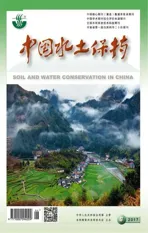SOIL AND WATER CONSERVATION IN CHINA No.6(423) 2017
2017-01-21
SOIL AND WATER CONSERVATION IN CHINA No.6(423) 2017
s
In order to solve the puzzling questions of poor water storage and fertilizer retention ability, low organic matter content of gray brown desert soil, and low and unstable maize seed production grown on it, the paper studied the effects of improved gray brown desert soil of Gansu Corridor by using multifunctional soil conditioner and the method of field testing through selecting gray brown desert soil of Suzhou District of Jiuquan City. The outcomes show that the optimum recipe proportion of the multifunctional soil conditioner is soil conditioner 0.928 8∶water retaining agent 0.001 2∶soil nutrient 0.068 1∶soil structure-improving agent 0.001 9. Through regression statistical analysis, the optimum fertilizer rate on economic benefits of multifunctional soil conditioner is 24.22 t/hm2and the theoretical yield of corn for seed is 6.76 t/hm2. Comparing with applying multifunctional soil conditioner and traditional chemical fertilizer, the bulk density, pH value and the contents of Hg, Cd, Cr and Pb of gray brown desert soil are reduced by 7.20%, 5.51%, 16.21%, 28.85%, 15.74% and 18.02% respectively, total porosity, aggregate content >0.25 mm, total moisture capacity, organic matter content, alkali hydrolyzable nitrogen content, available phosphorus content and available potassium content increased by 6.44%, 27.35%, 6.43%, 20.12%, 0.80%, 0.96% and 0.16% respectively, fungus, germs, actinomyces, invertase, urease, phosphatase and PPO increased by 117.31%, 34.83%, 22.06%, 61.48%, 45.92%, 34.78% and 60.32% respectively and the yield of corn for seed and fertilization profit increased by 7.15% and 29.70% respectively. Applying multifunctional soil conditioner has improved the physicochemical property of gray brown desert soil of Gansu Corridor and increased the economic benefits of corn.
Key words: multifunctional soil conditioner; gray brown desert soil; improvement effect; Gansu Corridor
Soil Physical and Chemical Properties of Typical Small Watersheds in Low Mountain Valley Area of Chishui in Guizhou: Taking Banshangou Small Watershed in Changqi Town of Chishui City as an Example
LIAO Xiaofeng, XIAO Jiujun, XIE Yuangui, et al.
(Guizhou Mountain Resources Research Institute of Guizhou Academy of Sciences, Guiyang, Guizhou 550001,China)(38)
The paper studied the physical and chemical properties of soil profile and its spatial variations under the conditions of different types of land use of Banshangou small watershed in Changqi Town of Chishui City, which is a typical small watershed situated in low mountain valley area of Chishui City in Guizhou Province by using the method of field sampling and laboratory test analysis. The outcomes show that a) viewing from spatial distribution, the soil organic matter and partial soil nutrient of plow layer has the situation of down stream >upper stream >middle stream; b) under the conditions of different land use, the soil bulk density of plow layer shows dry land >bamboo forest >woods >paddy fields and soil porosity and field moisture capacity shows paddy fields >woods >bamboo forest >dry land. The various nutrient contents of woods are all higher than that of bamboo forest soil. The contents of soil organic matter, total nitrogen, available nitrogen, total phosphorus and total potassium are all slightly higher than that of dry land, while the contents of available phosphorus and available potassium are all slightly lower than that of dry land and; c) viewing from soil profile distribution, the soil bulk density and pH value are increased along with the increase of soil depth, the field moisture capacity is decreased along with the increase of soil depth, the contents of soil organic matter, total nitrogen, total phosphorus and available phosphorus show the trend of decreasing from up to down and the content of potassium of paddy fields shows the characteristic of first increase and then decrease from up to down.
typical small watershed; soil physical and chemical properties; low mountain valley; Chishui City of Guizhou Province
Temperature and Humidity Effect of Surrounding Towns and Plantation of Dongping Lake
YAN Keru, JING Shuhui, ZHANG Tianju, et al.
(School of Environment and Planning, Liaocheng University, Liaocheng, Shandong 252059,China)(42)
The paper measured the temperature, humidity and the intensity of sunlight of surrounding towns and plantation of Dongping Lake by using portable automatic observation meteorological station and analyzed the differences of temperature and humidity of the surrounding towns and plantation of the lake and the reasons. The outcomes show that a) the fluctuations of temperature and humidity of the surrounding towns are affected by the lake. It shows that the fluctuation of the town which is closer to the lake is greater and the variations of temperature and humidity of poplar plantation in different distances to the lake also show the closer the greater. The variation is mainly caused by cold and wet action of wetland of the lake; b) comparing with the plantation and town that are in the same distance to the lake, the temperature of town is obviously higher than that of plantation, but the maximum increasing value of temperature of plantation at 9:00-10:00 a.m. is 3.4 ℃ and the maximum increasing value of temperature of town at 10:00-11:00 a.m. is 2.8 ℃, showing greater fluctuation of plantation and; c) before 9:00 a.m., the relative humidity of atmosphere of plantation is greater than that of town, after 9:00 a.m., the relative humidity of atmosphere of plantation is obviously lower than that of town and the variation of relative humidity of atmosphere of town is smaller, showing the vegetation has an important function in cold and wet effect regulation of the lake.
Key words: wetland of Dongping Lake; cold-humid effect; temperature; humidity
Improvement Effect of Multifunctional Soil Conditioner to the Gray Brown Desert Soil of Gansu Corridor
MA Zhenglong1, LI Shifeng2, YAN Zhibin2, et al.
(1.Jiuquan Academy of Agricultural Sciences, Jiuquan, Gansu 735000,China; 2.Research Institute of Gansu Dunhuang Seed Co., Ltd., Jiuquan, Gansu 735000,China)(46)
